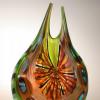
Murano GLass History - PT 3 - 18th Century to 1910
The emigration of talent had its effect on Venice’s preeminence in glassblowing. Other countries used the once secret knowledge divulged by the maestri of Murano to create their own styles and interpretations of glass. Bohemian crystal, thicker, heavier and often engraved, grew in popularity to the point of rivaling Murano glass’ popularity the century before. This change in taste towards a more robust glass and the fall and occupation of the Venetian Republic by Napoleon’s troops in 1797 combined with the subsequent abolishment of the Guild in 1805 precipitated a long lasting crisis in Venice.
The first half of the 19th century saw many Murano furnaces shuttered and its artists scattered throughout Europe. The surviving shops did not produce the beautiful works of art they had been known to make only a few decades earlier, rather; they were only making beads, small bottles and other trinkets needed for trade. This reversal of fortune lingered until the 1860’s, when Vincenzo Zanetti developed the Glass Museum of Murano, (in reality more of a school than a museum) and slowly began reintroducing lost glass blowing techniques.
During the same time, Antonio Salviati opened Salviati & Co. and began producing wonderful pieces that hadn’t been seen in 200 years. The artists at his furnace became so adept, they won numerous awards at the 1867 Universal Exposition in Paris. By the 1890’s glass making in Murano was showing signs of reinvigoration, and Salviati & Co. was bought by Barovier after Salviati’s death in 1890. Ironically, the rediscovery and utilization of a murrine, a glass working technique from Roman times, is partially responsible for restoring the Murano glass industry in the late 1800’s.
In 1896, the first Venice Biennale show opened, allowing Muranese masestri to meet, share ideas, and establish relationships with other like-minded artists from other nations. The results of this seminal meeting can still be seen today in the maestri’s close collaboration with artists worldwide. However, once again, the furnaces were confronted with stiff competition from foreign glassmakers including Tiffany and Lalique.
Around this time, the company Fratelli Toso was beginning to be recognized for its works with a murrine, but World War I interrupted the fledging recovery of Muranese craftsmanship, and it wasn’t until the 1920’s, three artists, Vittorio Zecchin, Paolo Venini, and Giacomo Cappellin began creating new works with simple lines, delicate colors and the thinnest of glass. One of the pivotal players in the modern Murano era is Paolo Venini. An unlikely candidate, an attorney with no experience in glassblowing, he was known for his willingness to collaborate with others in diverse fields, especially from the world of architecture. One of his greatest contributions to Murano in the 20th century was developing upcoming artists. The list of artists his company mentored over the years reads like a who’s who of the modern Venetian art world. In 1921, Paolo Venini teamed up with Giacomo Cappellin to establish a new company named V.S.M. Cappellin Venini & Co. Their pieces, created by Vittorio Zecchin, were immediately recognized to be exceptional works of craftsmanship combined with a delicate sophistication. However, the partnership didn’t last long, and they parted in 1925
Visit our website at http://www.italiandecor-glasslights.com for more information
